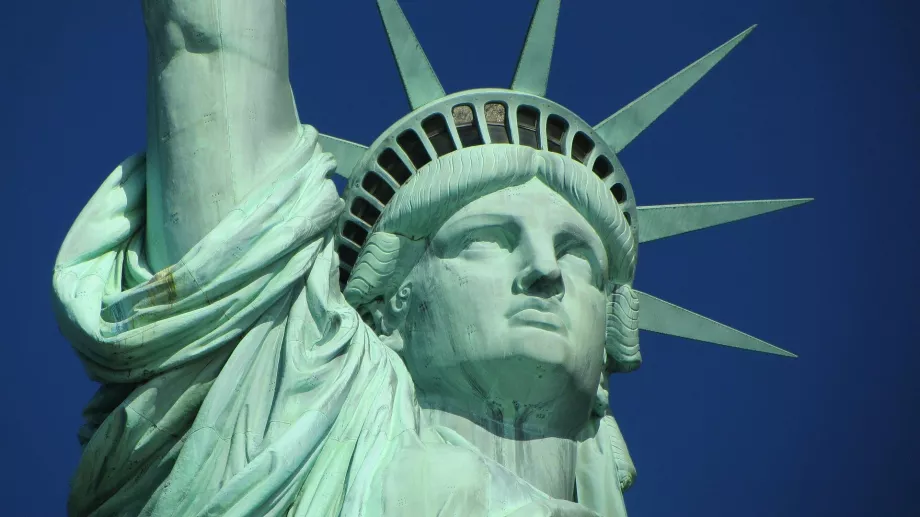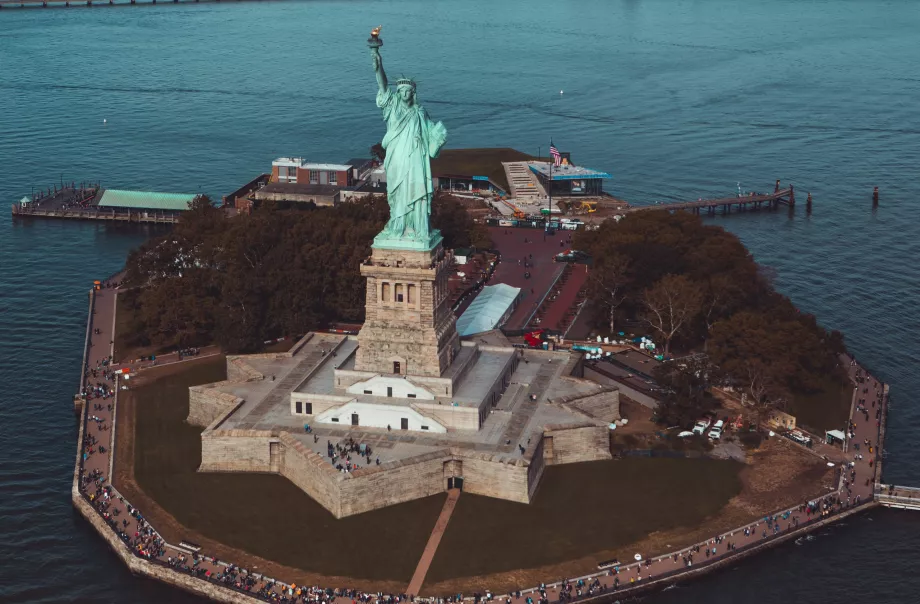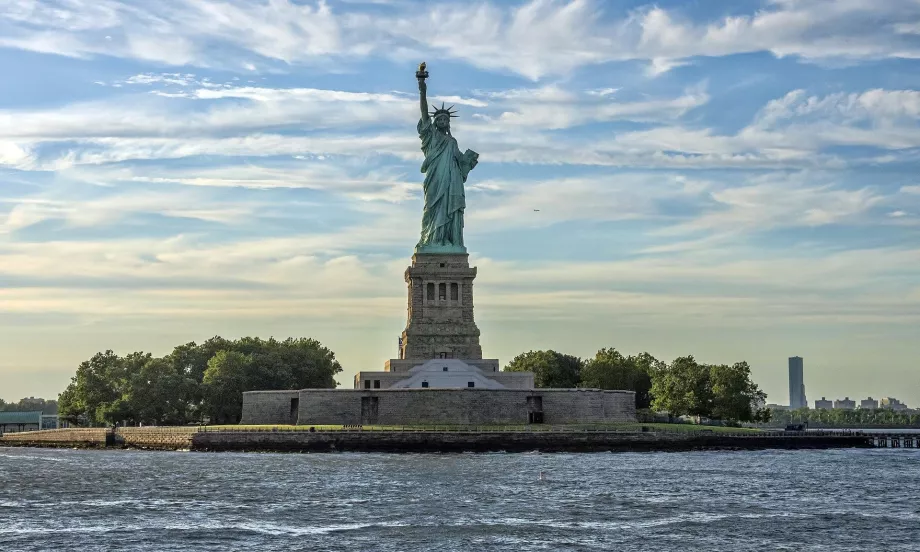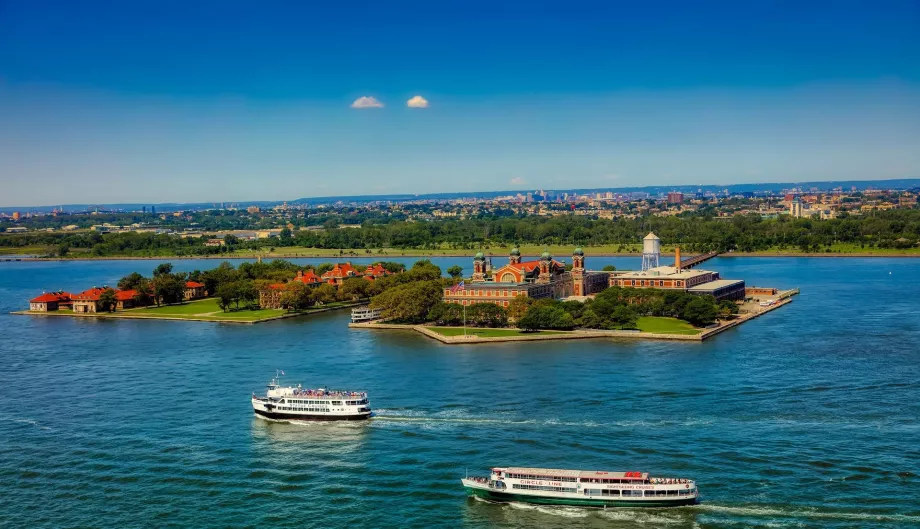Statue of Liberty

The Statue of Liberty is the symbol of New York, and of America as a whole. The neoclassical copper statue commemorates the friendship and help that France extended to American settlers in 1776 in their fight for independence from Great Britain. The Symbol of Liberty has stood on Liberty Island below Manhattan since 1886 and is now one of the world's most sought-after tourist attractions.
The 10 best hotels in New York City
The statue itself depicts the Roman goddess of freedom, Libertas. In her right hand, she holds a torch raised above her head, while in her left hand she clutches a plaque with the inscription JULY IV MDCCLXXVI, which is the date in Roman numerals for July 4, 1778, the day the US declared independence.
At the base of the statue are depicted broken chains, a symbol of emancipation from slavery.
The height of the Statue of Liberty and a visit to the crown
The copper statue itself measures 46 metres from the feet to the tip of the torch, but it stands on a 47-metre high granite base, making the total height from the ground 93 metres.
There is a viewing platform in the crown, which the statue wears on its head, that can be visited. However, access is only by stairs, with an elevator only taking you to the top of the granite pedestal, and the 46-metre-high statue itself can only be reached by 162 narrow and steep stairs, which are more like a ladder.
Entrance fees and ferries
The Statue of Liberty on Liberty Island can only be accessed by purchasing tickets on the website statuecruises.com. Tickets include boat transportation from the Battery Park dock or the Liberty State Park dock in New Jersey.
There are 3 ticket options to choose from, prices from both ports are the same:
- General Admission – 24,50 USD Including admission and ferries to Liberty Island and Ellis Island, as well as admission to the small Statue of Liberty Museum,
- Pedestal Reserve Ticket – 24,80 USD plus admission to the Statue of Liberty's pedestal. Tickets are limited in number and require early reservations,
- Crown Reserve Ticket – 24,80 USD allows you extra access to the crown. Please make your reservations at least 4-6 months in advance.
Boats depart from Battery Park every 15-20 minutes from 8:30am to 4:00pm.
- Statue of Liberty National Monument Official Website: nps.gov/stli
- The only official ticket seller and ferry operator: statuecruises.com
How to see the Statue of Liberty for free?
If you don't feel like paying, you can also see the Statue of Liberty from a few dozen yards away on the Staten Island cruise. The boat departs every 30 minutes from Staten Island Ferry (about 5 minutes from Battery Park) and is free.
Boats sail to Staten Island 24 hours a day, so feel free to enjoy the nighttime views as well.
Other great views of the statue can be had directly from Battery Park or Liberty State Park in New Jersey, where the ferries depart from.
Accommodation with a view of the Statue of Liberty
Want to keep the symbol of America in sight? Book a stay at one of the luxury hotels that offer views of the South Fork of the Hudson River and, by extension, the statue itself.
- Hyatt Regency Jersey City **** in New Jersey
- Casa Cipriani New York ***** in Manhattan
The Story and History of the Statue of Liberty
You already know the most practical information you need to visit, but how and where did the statue actually come to be?
France's gift to the Americans
The initial idea for a grand monument to liberty came from the mind of a French marquis named Édouard René de Laboulay, president of the French Anti-Slavery Society and an important thinker of the time. After all, it was the French who made a significant contribution to the independence of the United States when they fought side by side with them against the British. Laboulaye hoped that France's formidable gift would also build up the French people to overthrow the reign of terror of Napoleon III.
Fréderic August Bartholdi was commissioned as the chief sculptor, who, on a visit to New York, was intrigued by the very small island at the entrance to the harbor that all ships had to pass by.
Lack of money and the intervention of Pulitzer
The first proposal came in 1870, but the project was constantly struggling with a lack of money and, at first, with a very lukewarm attitude of New Yorkers, who began to change their minds only after the threat that the statue would eventually be built in Boston.
The original completion date of 1876 (the 100th anniversary of US independence) was missed, and so the completed torch arm was sent to the World's Fair in Philadelphia. It took another 10 years before the statue was completed and on July 4, 1886 it was unveiled in Paris, where it was being completed.
After that it was again disassembled into 300 parts and sent by ship to New York, where, again due to lack of funds, the massive granite base was still missing. Efforts to raise contributions for its construction from wealthy businessmen were unsuccessful, and it was the famous journalist Joseph Pulitzer who was instrumental in raising sufficient funds. He came up with a massive campaign in his newspaper, The World, with the idea that the statue was a gift from the French people to the American people. After this announcement, ordinary Americans began to contribute on a large scale to the construction of the pedestal.
The final unveiling took place in New York City on October 28, 1886.
What to see around
Discover all the places to see in New York.
Any questions left?
If you have any questions or comments about the article...










